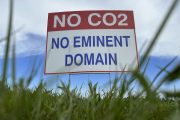As the United Nations met in Marrakesh, Morocco, to devise more ways to loot wealthy countries under the guise of halting “climate change,” one of the world’s foremost climate-change skeptics delivered what should have brought the entire conference to a swift conclusion: a 44-page report debunking many of the claims of the global-warming alarmists.
Marc Morano, the publisher of ClimateDepot.com, presented the UN Climate Change Conference with his 2016 State of the Climate Report. The report covers a variety of topics, including global temperatures, sea levels, and even terrorism, all of which are ostensibly linked to mankind’s pouring carbon dioxide (CO2) into the atmosphere.
Morano begins his report thus:
CO2 is not the tail that wags the dog. CO2 is a trace essential gas, but without it life on earth would be impossible. Carbon dioxide fertilizes algae, trees, and crops to provide food for humans and animals. We inhale oxygen and exhale CO2. Slightly higher atmospheric CO2 levels cannot possibly supplant the numerous complex and inter-connected forces that have always determined Earth’s climate.
Increased CO2 levels are hardly something to fear. The current average level of CO2 in the air is 390 parts per million (ppm), well below the historical norm. Indeed, observes Morano,
Scientists note that geologically speaking, the Earth is currently in a ‘CO2 famine’ and that the geologic record reveals that ice ages have occurred when CO2 was at 2000 ppm to as high as 8000 ppm. In addition, peer-reviewed studies have documented that there have been temperatures similar to the present day on Earth when carbon dioxide was up to twenty times higher than today’s levels.
Given that CO2 is only one factor among many affecting the climate and that its effects are still a matter for debate, nations should be wary of implementing various UN treaties that purport to stop alleged global warming through massive wealth transfers. German economist Ottmar Edenhofer, who co-chaired the Intergovernmental Panel on Climate Change (IPCC) Working Group III, stated, “One must say clearly that we redistribute de facto the world’s wealth by climate policy…. One has to free oneself from the illusion that international climate policy is environmental policy. This has almost nothing to do with environmental policy anymore.” Yet Edenhofer had the audacity to call skepticism of climate-change alarmism “an unethical, unacceptable position.”
The fact is, Morano points out, global temperatures have hardly changed at all over the past 18 years, contrary to the prognostications of computer models that also forecast massive global warming in the distant future. If these models can’t even predict short-term temperature changes, how likely are they to be accurate about temperatures decades from now?
Alarmists have warned that increasing global temperatures, which they insist are still occurring, will have numerous dire outcomes, yet Morano shows that most of these predictions have not panned out.
For instance, polar ice is supposed to melt, causing sea levels to rise and to swamp coastal regions. In fact, notes Morano, sea levels have been rising for millennia, and the rate of rise has actually decelerated over the last century, to the point where sea levels are now increasing about the thickness of a penny or two each year. Moreover, any current rise cannot be attributed to melting ice because both the Arctic and Antarctic ice sheets are not shrinking. Antarctica, as it happens, is even helping to reduce sea levels by 0.23 millimeters per year, according to a 2015 National Aeronautics and Space Administration study.
Polar bears, who supposedly are threatened with extinction because of the melting ice, are also doing quite well. “Polar bears are at or near historic population highs,” writes Morano. “The only threats they face are from virtual world computer model predictions that do not reflect reality or account for the adaptability of these animals,” who have survived many periods of climate warmer than that of the present.
Alarmists also warned that climate change would have a negative impact on humans’ ability to feed themselves, although anyone who gave that a moment’s thought could see that warmer temperatures mean longer growing seasons and more CO2 means more and healthier plants. Morano lists a number of studies finding that the increase in atmospheric CO2 over the last century has indeed led to bumper crops. The problem for much of the world today is not starvation but obesity.
Another alleged threat from global warming was more frequent extreme weather events such as hurricanes, tornadoes, floods, and droughts. However, notes Morano, such events have become much less frequent in recent years. The United States has experienced five years of below-average tornado activity and a record 11 consecutive years without a major hurricane strike. Globally, floods and droughts show no signs of increasing in frequency; past droughts, as a matter of fact, were far worse than those of today.
Climate change is even supposed to cause more wars, according to some, including the U.S. Department of Defense. Morano puts that allegation to bed with links to studies showing that more wars happened during cooler periods than during warmer periods and that “the primary causes of civil war are political, not environmental, and although environmental conditions may change with future warming, general correlates of conflicts and wars are likely to prevail.”
Morano employs quite a bit of sarcasm in skewering the climate alarmists. He documents how many of the claims currently being made about global warming were, back in the 1970s, attributed to an oncoming global cooling. In addition, he offers a litany of instances in which climate change was alleged to have a particular effect and later alleged to have precisely the opposite effect. For example, global warming was said to cause the Earth to spin both faster and more slowly; to produce both milder and harsher winters; to cause both more and fewer hurricanes; and even to make San Francisco both foggier and less foggy.
Finally, Morano debunks the notion that “97 percent of scientists agree” with the theory of anthropogenic climate change, showing that there is no basis in fact for such an assertion.
One can only hope that Morano’s report will cause at least a few movers and shakers to rethink their devotion to climate-change orthodoxy. After all, even if the UN got everything it wants in its various climate conferences, it would do little to affect global temperatures. “None of the strategies that have been offered by the U.S. government or by the EPA or by anybody else has the remotest chance of altering climate if in fact climate is controlled by carbon dioxide,” geologist Dr. Robert Giegengack wrote in 2014. As Morano put it, “Even if we actually faced a climate catastrophe and we had to rely on a UN climate agreement, we would all be doomed!”
Sadly, most true believers in anthropogenic climate change are so in thrall to it — and its potential for global wealth redistribution — that Morano’s report isn’t likely to change many minds. In the words of Nobel Prize-winning physicist Dr. Ivar Giaever, “Global warming really has become a new religion.”




